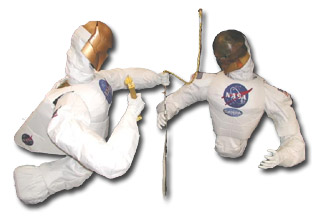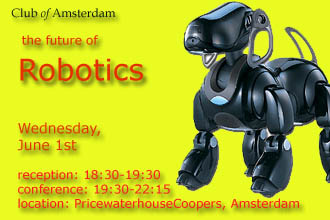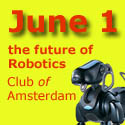
Content
Human-like NASA Space Robot Goes Mobile with Leg, Wheels
StoryCast: simple, digital storytelling with photos and narration
Recommended Book: Natural-Born Cyborgs: Minds, Technologies, and the Future of Human Intelligence
First Commercial Wave Farm
Agenda
Club of Amsterdam Open Business Club
Club of Amsterdam Search
Submit your article
Contact
Subscribe
Human-like NASA Space Robot Goes Mobile with Leg, Wheels
| Human-like NASA Space Robot Goes Mobile with Leg, Wheels Human-like hands, fingers and even television camera eyes have been hallmarks of NASA’s Robonaut, but recent work seeks to give the nimble robot legs, or at least a leg, and even wheels. Robonaut took its first steps recently during tests at the Johnson Space Center in Houston, using a single “space leg” to move around the outside of a simulated Space Station. Other recent tests put the humanoid robot on wheels, a Segway scooter to be exact, and let it take to the road. In either configuration, Robonaut’s head, torso, mechanical arms and hands maintain their ability to use the same space tools as humans. In the tests using its “space leg,” Robonaut commuted like a futuristic construction worker hand-over-hand outside a mock spacecraft. Aboard the gryo-stabilized wheels, it glided from one test station to another as its descendants might someday on the surface of the Moon or Mars. | |
 Tests with the leg confirmed that Robonaut could climb around the outside of a spacecraft using handholds and plant its foot at a work site to make repairs or install parts. NASA’s goal is to build robots that could ‘live’ on the outside of spacecraft, ready for routine maintenance or emergencies. Humans inside the spacecraft would operate Robonaut with wireless controls. The wheeled tests provided initial proof of concept for planetary Centaurs that merge humanoid robots with rovers. Those tests put Robonaut through its paces while mounted on a Segway Robotic Mobility Platform. They showed that a single teleoperator could simultaneously control both the robot’s mobility and dexterity with a wireless control system. The climbing tests were a significant step in Robonaut’s development, proving the system’s capability for climbing, stabilizing and handling extravehicular activity (EVA) tools and interfaces in the space environment. The test featured a battery-powered, wireless Robonaut system mounted to an air-bearing sled, floating on a cushion of air, to eliminate friction and emulate the sensations experienced by astronauts working in zero gravity. Robonaut climbed using EVA handrails and plugged its stabilizing ‘space leg’ into a standard space station WIF (Worksite Interface Fixture) socket, while its operators drove Robonaut’s multiple limbs using innovative new telepresence controls. “This test proved Robonaut can be operated wirelessly using an interchangeable base for different stabilization and locomotion systems — and it did it in a frictionless, space-like environment,” said Test Conductor Dr. Robert Ambrose of JSC’s Automation, Robotics and Simulation Division. “These are all key capabilities needed for the development of future ‘EVA squads’ that leverage the combined talents of humans and robots to make vast improvements in spacewalk productivity.” The Robonaut Project, which Ambrose leads, is a collaborative effort with the Defense Advanced Research Projects Agency (DARPA), and has been under development at JSC for several years. There are two Robonauts, each with highly dexterous hands that can work with the same tools humans use. Operators remotely control movements of the Robonauts’ heads, limbs, hands and twin cameras through a combination of virtual-reality interfaces and verbal commands, relayed either through dedicated cabling or wireless systems. In order to move about in a zero-gravity environment, a robot must be able to climb by itself, using gaits that smoothly manage its momentum and that minimize contact forces while providing for safety in the event of an emergency. To access worksites aboard the International Space Station and future spacecraft, robots must interact with spacewalking aids designed for humans including tethers, handrails and work anchors. “The tests were very successful,” Ambrose said. “The Robonaut team learned which climbing maneuvers are more feasible than others, and tested automated software safety reactions using the robot’s built-in force sensors. We also identified new opportunities for using these sensors in semi-automatic modes that will help operators across short (1-10 second) time delays. Our team will continue to tackle these challenges as NASA looks forward to applying human-robotic interaction to the tasks associated with returning to the Moon and going on to Mars.” |

News about Robotics

Roboclimber prevents landslides
The Roboclimber robot can secure slopes without endangering human lives. It has been constructed using expertise and technology from Europe’s space programmes. Weighing 3800 kg, with four legs and with a square base of 2 metres by 2.5 metres, Roboclimber is one of the largest robots in the world, yet still very agile and easily controllable. The on-board control system includes algorithms based upon ESA advanced methodology for controlling satellites in space.

Cornell researchers build a robot that can reproduce
One of the dreams of both science fiction writers and practical robot builders has been realized, at least on a simple level: Cornell University researchers have created a machine that can build copies of itself.
Admittedly the machine is just a proof of concept — it performs no useful function except to self-replicate — but the basic principle could be extended to create robots that could replicate or at least repair themselves while working in space or in hazardous environments, according to Hod Lipson, Cornell assistant professor of mechanical and aerospace engineering, and computing and information science, in whose lab the robots were built and tested.
News about the Future

Nanoparticles used in dentistry
Dr. Reifman has a new, painless, needle-free way to treat receding gums. It goes like this: A jet of fine air mixed with minute sand particles are focused on the receded area to clean and sterilize it. This procedure is totally painless and requires no anesthesia at all! A moment later, the area is then gently rinsed off with water, briefly dried, and a strong liquid adhesive is applied.
A new, white bonded filling material containing nano-particles to make it strong and longer-lasting is applied to fill the area (see images below). This tooth-colored, state-of-the-art nanomaterial is then hardened with a high-intensity blue light. Any excess material is gently removed and the treatment is done.

As the earth evolves
By Discovery Communications
How will Earth look 5 million, 100 million, even 200 million years from now? Listen to professor Stephen Palumbi, a Stanford University biologist, explain as you watch the transformation in the movie slide show.
Next Event: Wednesday, April 27

the future of Robotics
Wednesday, June1, 2005
reception: 18:30-19:30, conference: 19:30-22:15
location: PricewaterhouseCoopers, Prins Bernhardplein 200, Amsterdam [next to Amstelstation], free parking.
Léon Rosenkrantz: AIBO as an intelligent robot
Bart de Boer: Robotics for AI and AI for Robotics
Christoph Bartneck: Social Robots
StoryCast: simple, digital storytelling with photos and narration
StoryCast: simple, digital storytelling with photos and narration
by Hewlett-Packard Development Company
StoryCast is an experimental digital storytelling service that lets people use their camera phones and other mobile devices to easily create and instantly share stories with friends and family. Each story consists of a sort of narrated slide show of photos accompanied by the storyteller’s voice.
StoryCast is spontaneous. Users don’t have to wait until they arrive home or travel to a WIFI hotspot to create and share stories. Just as the Polaroid made it easy to snap informal pictures that could be viewed instantly, camera phones present the opportunity to instantly share narrated photo journals.
How it works
Composition is radically simple: Using the mobile phone handset as a microphone, users speak into the phone while clicking on thumbnails of photos they want to describe or that illustrate a story. The user experience is similar to recording a traditional voicemail, with the benefit of allowing users to augment the audio track with pictures.
Once the handset has recorded both the audio track and the corresponding sequence of pictures, it sends the whole message via email, HTTP or MMS. The team implemented this prototype on a iPAQ h6315 camera phone running the pocket PC phone edition operating system. The organizational structure of a story can be represented in SMIL or MPV (XML formats for multimedia presentations).
Related work
We explored another implementation of this service based on a voice interface delivered by a server-side voice application, which uses the HP Opencall Media Platform.
To invoke the service, called Storymail, users call a number corresponding to their personal story mailbox. A voice menu offers a choice between recording, sending or playing back StoryCasts. During the recording phase, the voice message is transmitted live over the phone’s dedicated voice channel. Photos are transmitted afterwards over the separate data channel.
At playback, the the photo sequence is shown in synchronization with the voice narration, which is played by the voice server. Our implementation uses VoIP protocols (SIP and RTP) to transmit voice and SMTP to transmit the data. The client part consists of a software-simulated cell phone running on a PC.
Recommended Book

Natural-Born Cyborgs: Minds, Technologies, and the Future of Human Intelligence
by Andy Clark
From Robocop to the Terminator to Eve 8, no image better captures our deepest fears about technology than the cyborg, the person who is both flesh and metal, brain and electronics. But philosopher and cognitive scientist Andy Clark sees it differently. Cyborgs, he writes, are not something to be feared – we already are cyborgs.
In Natural-Born Cyborgs, Clark argues that what makes humans so different from other species is our capacity to fully incorporate tools and supporting cultural practices into our existence. Technology as simple as writing on a sketchpad, as familiar as Google or a cellular phone, and as potentially revolutionary as mind-extending neural implants – all exploit our brains’ astonishingly plastic nature. Our minds are primed to seek out and incorporate non-biological resources, so that we actually think and feel through our best technologies. Drawing on his expertise in cognitive science, Clark demonstrates that our sense of self and of physical presence can be expanded to a remarkable extent, placing the long-existing telephone and the emerging technology of telepresence on the same continuum.
He explores ways in which we have adapted our lives to make use of technology (the measurement of time, for example, has wrought enormous changes in human existence), as well as ways in which increasingly fluid technologies can adapt to individual users during normal use. Bio-technological unions, Clark argues, are evolving with a speed never seen before in history. As we enter an age of wearable computers, sensory augmentation, wireless devices, intelligent environments, thought-controlled prosthetics, and rapid-fire information search and retrieval, the line between the user and her tools grows thinner day by day.
“This double whammy of plastic brains and increasingly responsive and well-fitted tools creates an unprecedented opportunity for ever-closer kinds of human-machine merger,” he writes, arguing that such a merger is entirely natural.
A stunning new look at the human brain and the human self, Natural Born Cyborgs reveals how our technology is indeed inseparable from who we are and how we think.
First Commercial Wave Farm
First Commercial Wave Farm
Ocean front land owners concerned about preserving their expansive – often expensive – view of the ocean will likely put up fight against the construction of offshore wind farms in their view, even though the turbines might be only an inch tall on the horizon.
Sometime they’ll win in court and the windfarm won’t get built.
But there are other ways to harness the power of offshore wind that probably can’t be seen from shore – ocean wave energy. And that technology has suddenly become commercial.
Ocean Power Delivery (OPD) of Edinburgh, Scotland has received its first order for its Pelamis P-750 Wave Energy Converters. The company will deliver three of the 750-kilowatt devices for the first phase of an ocean wave farm being developed by Enersis off the coast of Portugal.
For a total capacity of 2.25 megawatts, the wave farm, to be built 5 kilometers off shore (about 3 miles) will generate enough power for up to 1500 homes. The project is valued at EUR 8 million ($10 million).
OPD expects Enersis to eventually buy up to 30 wave energy converters, up to 20 megawatts capacity, in 2006 if the first units operate as promised.
Pelamis ocean energy converters are a series floating cylinders connected together at power conversion modules. (They look like huge, red, floating snakes.) As the cylinders roll in the waves hydraulic rams, sliding at the connecting joints of the power conversion modules force hydraulic fluid to run hydraulic motors which, in turn, run electric generators. Power is cabled to shore.
Each 750-kilowatt Pelamis snake is 120 meters long and 3.5 meters in diameter (394 feet by 12) and is moored to the ocean bottom.
The Pelamis Wave Energy Converter has been chosen by the internationally-respected Electric Power Research Institute (EPRI) as the best and only wave energy device currently recommended for deployment off the U.S. coast.
Enersis is a Portuguese renewable energy developer with 500 megawatts of wind capacity and 100 megawatts of microhydro in its portfolio. Another 500 megawatts of wind capacity is being developed by the company.

Club of Amsterdam Agenda
| Club of Amsterdam Season 2004/2005 | |
| .June 1, 2005 | the future of Robotics |
| .June 29, 2005 | the future of Philosophy |

Club of Amsterdam Open Business Club








Customer Reviews
Thanks for submitting your comment!